This 3 Ingredient Pie Crust is so buttery, tender, and perfectly flaky. Made by hand with just flour, butter, and salt, this easy pie dough recipe requires no special equipment. It’s perfect for beginners and can be used to make both savory and sweet pies.
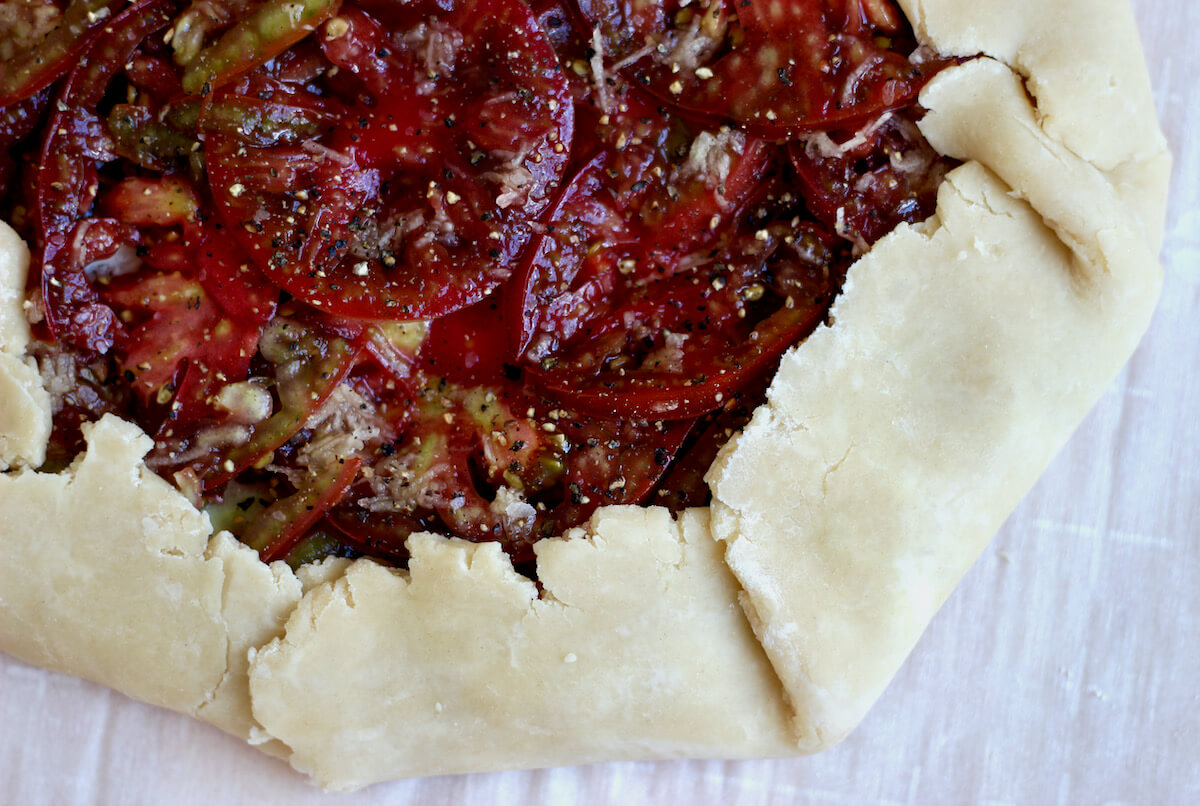
Every holiday season, I love making homemade pie crust. Simple, yet impressive, pie dough made from scratch adds a special touch to your holiday pie recipes that store-bought versions simply can’t match.
If you’ve never made your own pie crust, it can seem a little intimidating at first. But, this very easy pie crust recipe is made by hand with just 3 ingredients so, it’s perfect for beginners.
Today, I’m walking you through the entire pie dough making process including the secret to making the best pie crust, the best ingredients to use, and some of my favorite ways to use this 3 ingredient pie crust recipe.
Disclaimer: Some links throughout this post are affiliate links. As an Amazon Associate, I earn from qualifying purchases. You can learn more by visiting my Affiliate Disclosure Page.
What's the Secret to a Good Pie Crust?
The secret to the perfect pie crust is simple - keep the ingredients cold and don’t over-mix your dough.
Cold butter is essential for a flaky pie crust. Your goal is to prevent the butter from melting before it reaches the oven. Then, as the butter melts in the oven, it creates small pockets of air in the dough, which results in a tender, flaky pie crust.
Additionally, too much mixing can cause gluten to form, leading to a tough pie crust. For a tender, delicate crust, mix and knead your dough as little as possible.
Why You'll Love This Recipe
- Better Than Store-Bought- Pie dough is simply better when made at home. The flavor and texture of homemade pie crust are incomparable to store-bought.
- Tender & Flaky- Working the butter into the dough by hand results in lots of tender, flaky layers.
- Only 3 Ingredients- This easy all butter pie dough is made with just three simple ingredients. And you probably already have them in your pantry!
- No Special Equipment- The recipe is written so you can make this easy pie dough by hand - no food processor required!
- Versatile- This simple 3 ingredient pie crust works for both sweet and savory recipes, making it perfect for all occasions.
- No Added Ingredients- Homemade pie dough offers control over ingredients and avoids unhealthy fats and preservatives found in many store-bought crusts.
- Impressive- This pie dough is perfect for holiday gatherings and will surely impress your friends and family.
Ingredient Notes
Here are some notes on key ingredients. For a full list of ingredients, check out the recipe card below.
- All-Purpose Flour- For best results, measure the flour using a food scale. Alternatively, spoon it into a measuring cup and level it off with a knife.
- Unsalted Butter- The butter should be very cold, cut into small cubes, and kept in the refrigerator until ready to use.
- Kosher Salt- Enhances the flavor of the pie dough. I prefer using kosher salt because it's free from added sugar and anti-caking agents, which table salt often contains.
- Ice Water- Cold water prevents the butter from melting too soon, which helps create flaky layers in the pie dough.
- Sugar (optional)- Adding sugar is optional, but can be used to complement sweet fillings like fruit or custard.
🌱 Sustainability Tip: Use locally-milled flour and locally-sourced butter to make a pie crust that not only tastes amazing but also supports the environment and local farmers.
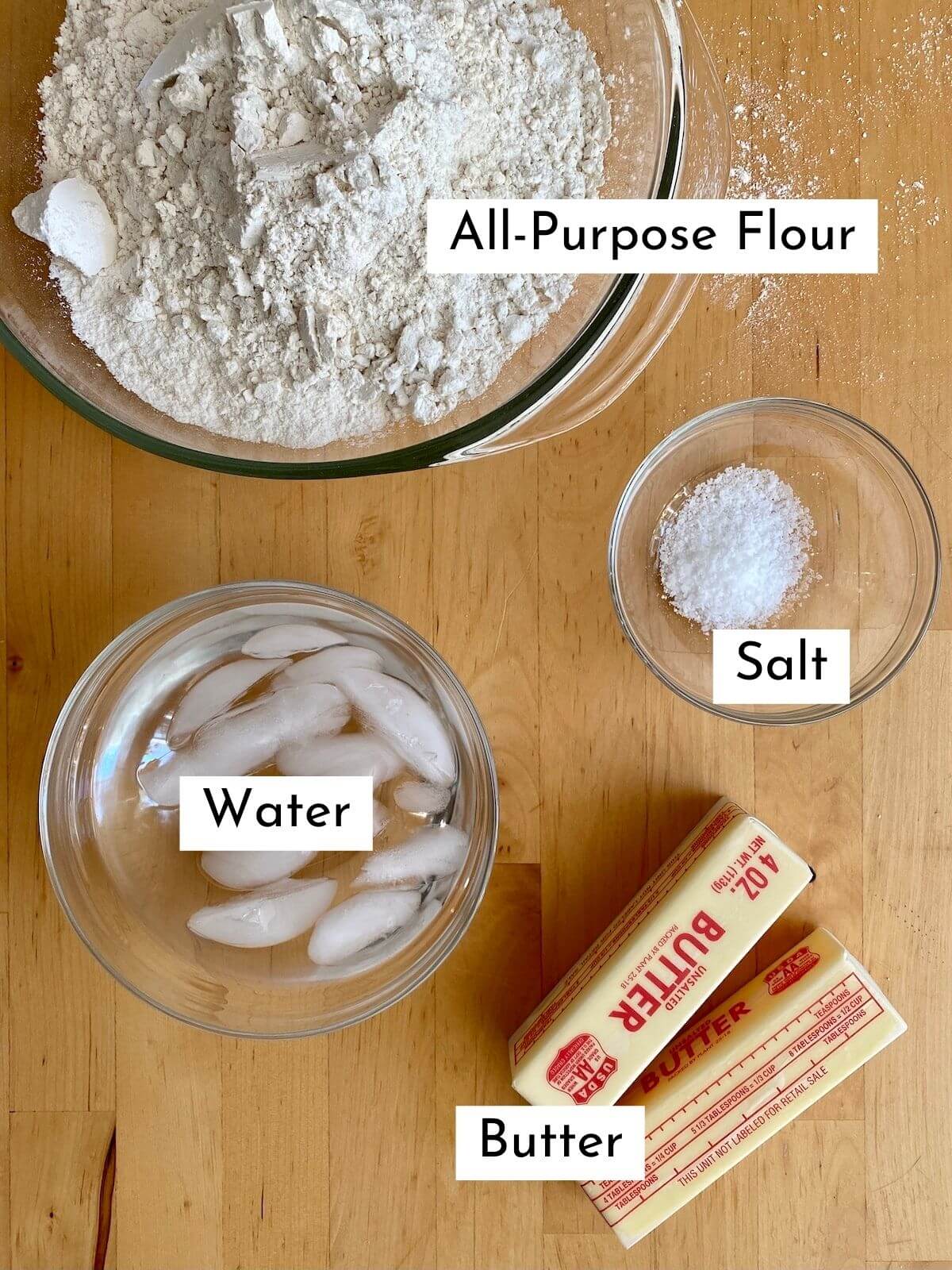
Substitutions and Variations
Here are a few ways you can try customizing this easy 3 ingredient pie crust recipe to fit your diet and taste preferences.
Substitutions
- All-Purpose Flour- Replace up to half of the all-purpose flour with whole wheat flour. Keep in mind that you may need to add a little more water.
- Unsalted Butter- Substitute some or all of the butter with vegetable shortening, lard, or bacon fat.
- Water- Many bakers use vodka in their pie dough to create even flakier layers. Swap half of the water for vodka if you want to give this one a try for yourself. You can also use milk in place of water.
- Kosher Salt- Both sea salt and table salt can be used in place of kosher salt.
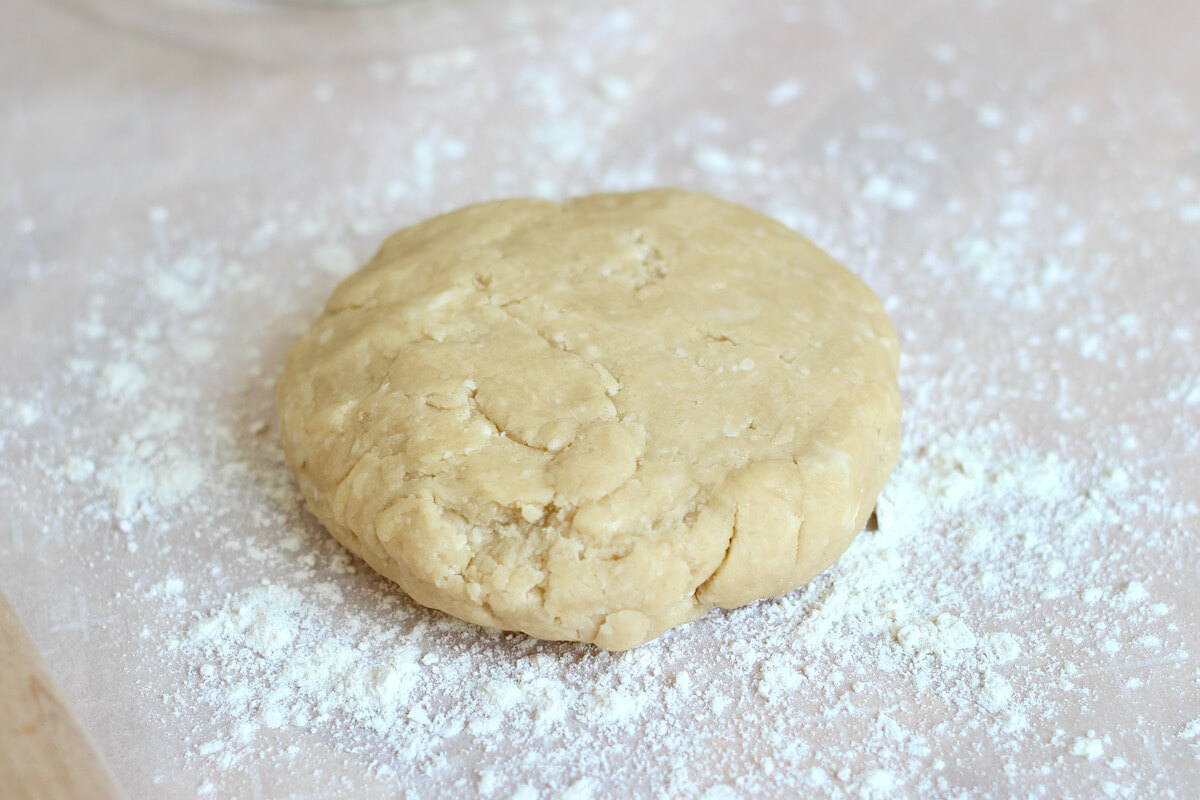
Variations
- Herbed- Add dried herbs like thyme, rosemary, or sage to the dry ingredients for a flavorful crust perfect for savory pies like quiches and pot pies.
- Cheddar- Add up to one cup of finely shredded cheddar cheese to the dry ingredients to make a cheddar pie dough.
- Cinnamon- Sprinkle a teaspoon of cinnamon in with the dry ingredients for a warmly spiced pie dough that pairs well with many sweet pie fillings, such as apple, pumpkin, or sweet potato.
- Chocolate- Replace ¼ cup of flour with ¼ cup of unsweetened cocoa powder to create a chocolate-flavored crust that complements chocolate, fruit, or cream pies.
Is Pie Crust Better With Butter or Shortening
When it comes to pie crust, the type of fat used can make a big difference in the final result.
Butter adds a rich, buttery flavor and creates a flakier texture. Shortening, on the other hand, produces a tender and crumbly crust that often holds its shape better when baked.
Personally, I prefer the flakiness, texture, and flavor of a pie crust made with all butter.
But, some bakers use a blend of butter and shortening to get the best of both worlds. Ultimately, the choice is a matter of personal preference. Experiment and see what works best for you.
Equipment Notes
Here are some notes on any special equipment I used to make this recipe.
- Kitchen Scale- It’s easy to over-measure flour when using measuring cups. Using a kitchen scale to measure the flour ensures you’re adding the right amount to the recipe.
- Pastry Blender (optional)- Using a pastry blender can be helpful for cutting the cold butter into the flour.
- Rolling Pin- A rolling pin is essential for rolling out your homemade pie dough.
How to Make 3 Ingredient Pie Crust
Here is how to make all butter pie crust.
By Hand
Step 1: Combine the dry ingredients. In a large mixing bowl, whisk together the flour, kosher salt, and sugar (if using) until everything is mixed well.
Step 2: Cut in the butter. Add the cold, cubed butter to the bowl. Using just your fingertips, pinch and squeeze the butter cubes until they flatten into small sheets. This helps create flaky layers in the dough.
Step 3: Continue working in the butter. Keep working the butter into the flour until it forms pea-sized crumbs. The mixture will look crumbly but should hold together slightly when pressed. Don't worry if you see a few larger butter pieces; they'll add to the flakiness.
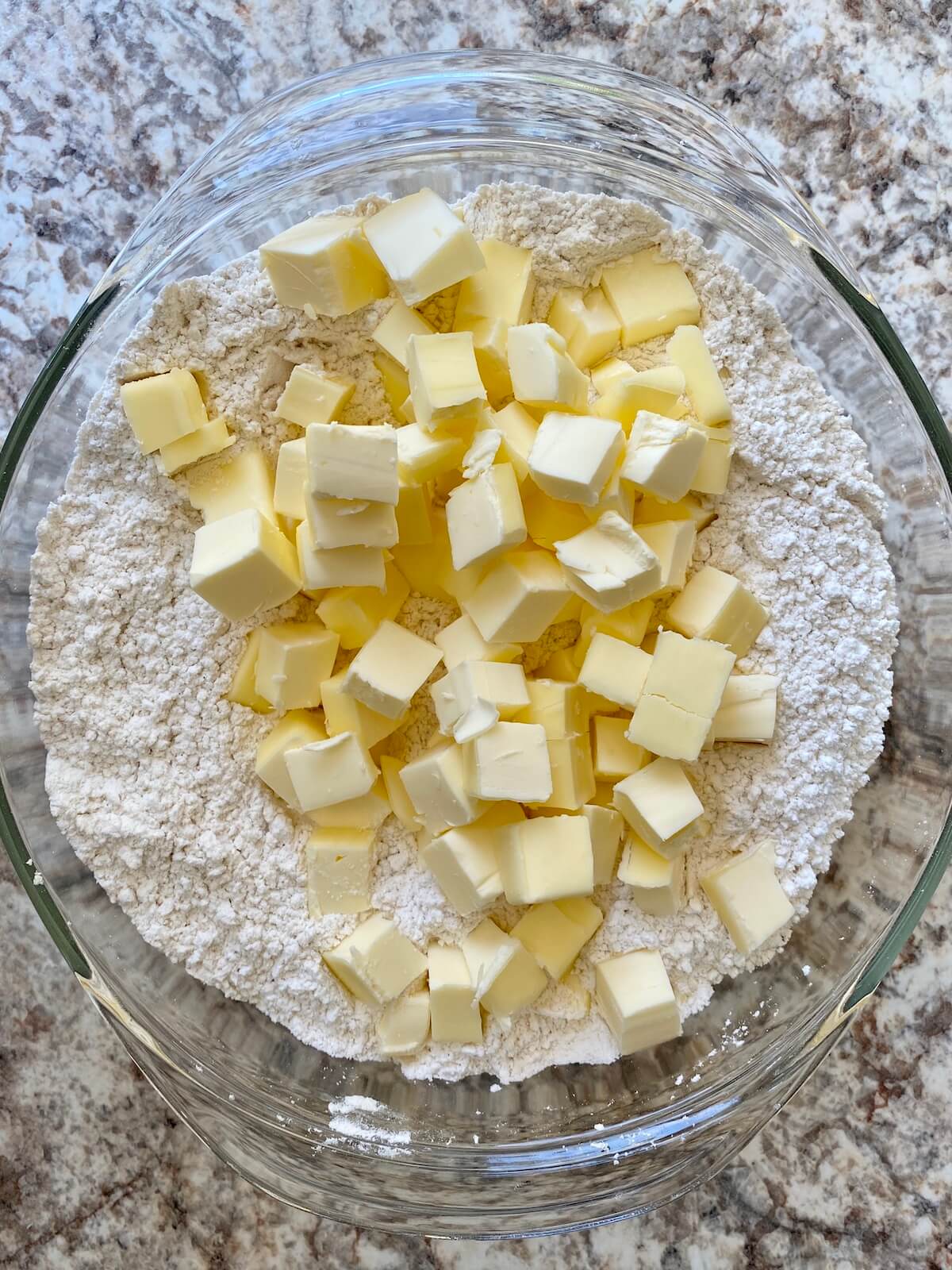
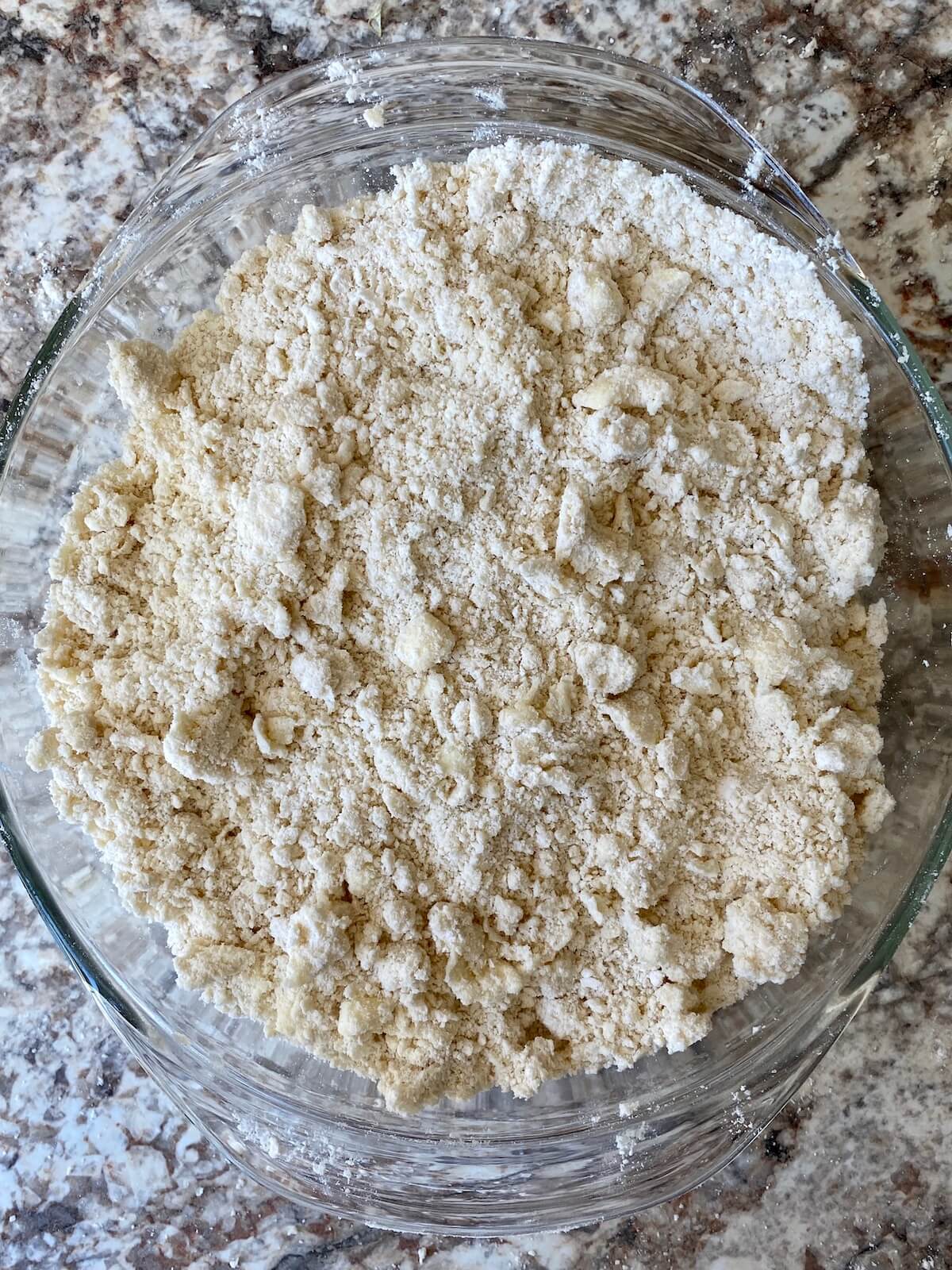
Step 4: Add cold water. Drizzle ¼ cup ice water evenly over dough. Gently mix with hands or spatula until flour is moistened. Be gentle, avoid over-mixing for a tender crust. Add water as needed, 1 tablespoon at a time. Stop adding water when dough holds together when pressed.
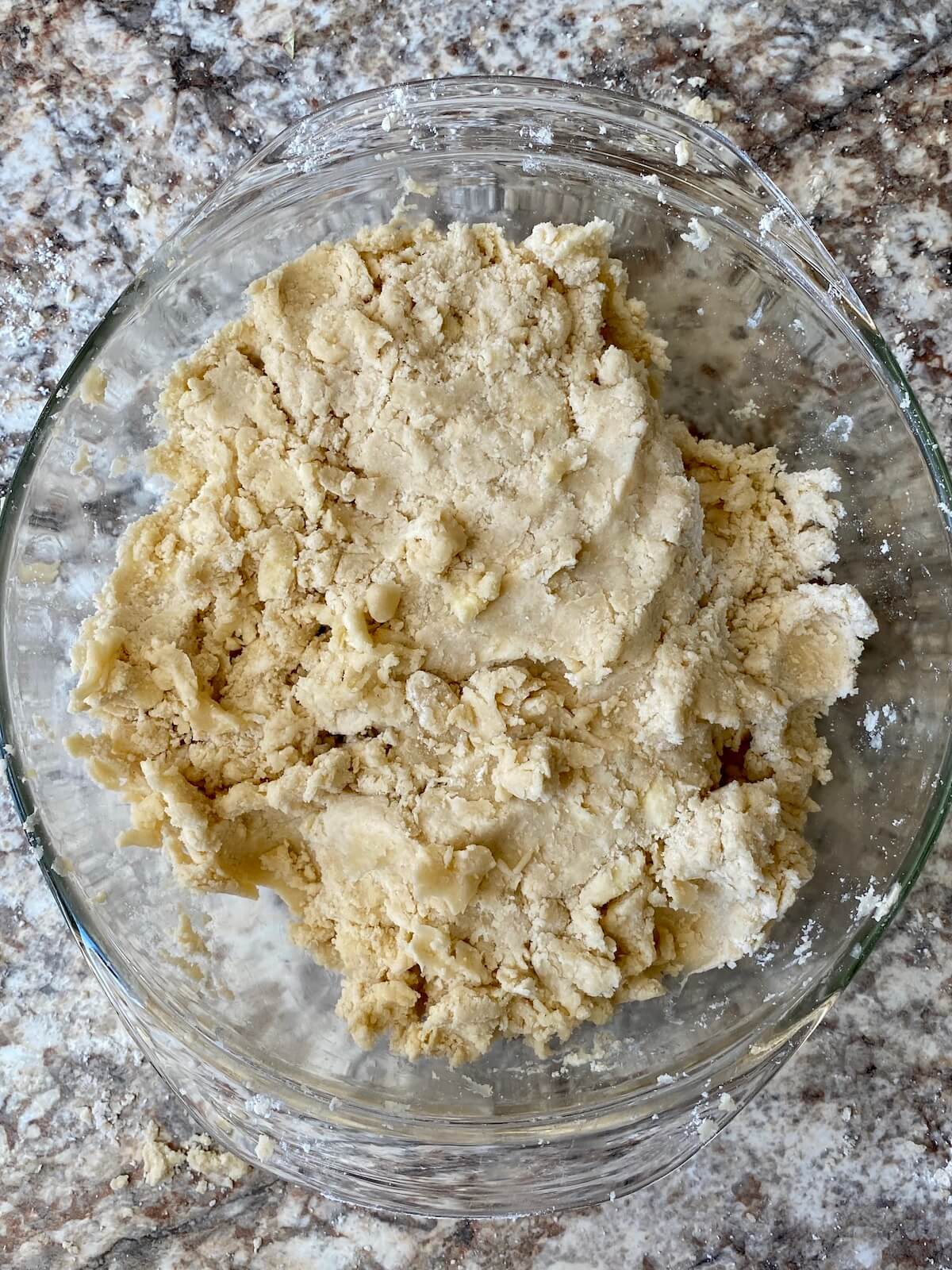
Step 5: Form dough balls. Dump the dough out onto a clean, lightly floured surface. Divide the dough into 2 equal parts and press each half together into a ball. Flatten each ball into a 1-inch thick disk.
Step 6: Chill the dough. Wrap each disk tightly in plastic wrap and refrigerate for 1 hour to 3 days. This relaxes the dough. Before rolling, let the disks sit on the counter briefly to warm up.
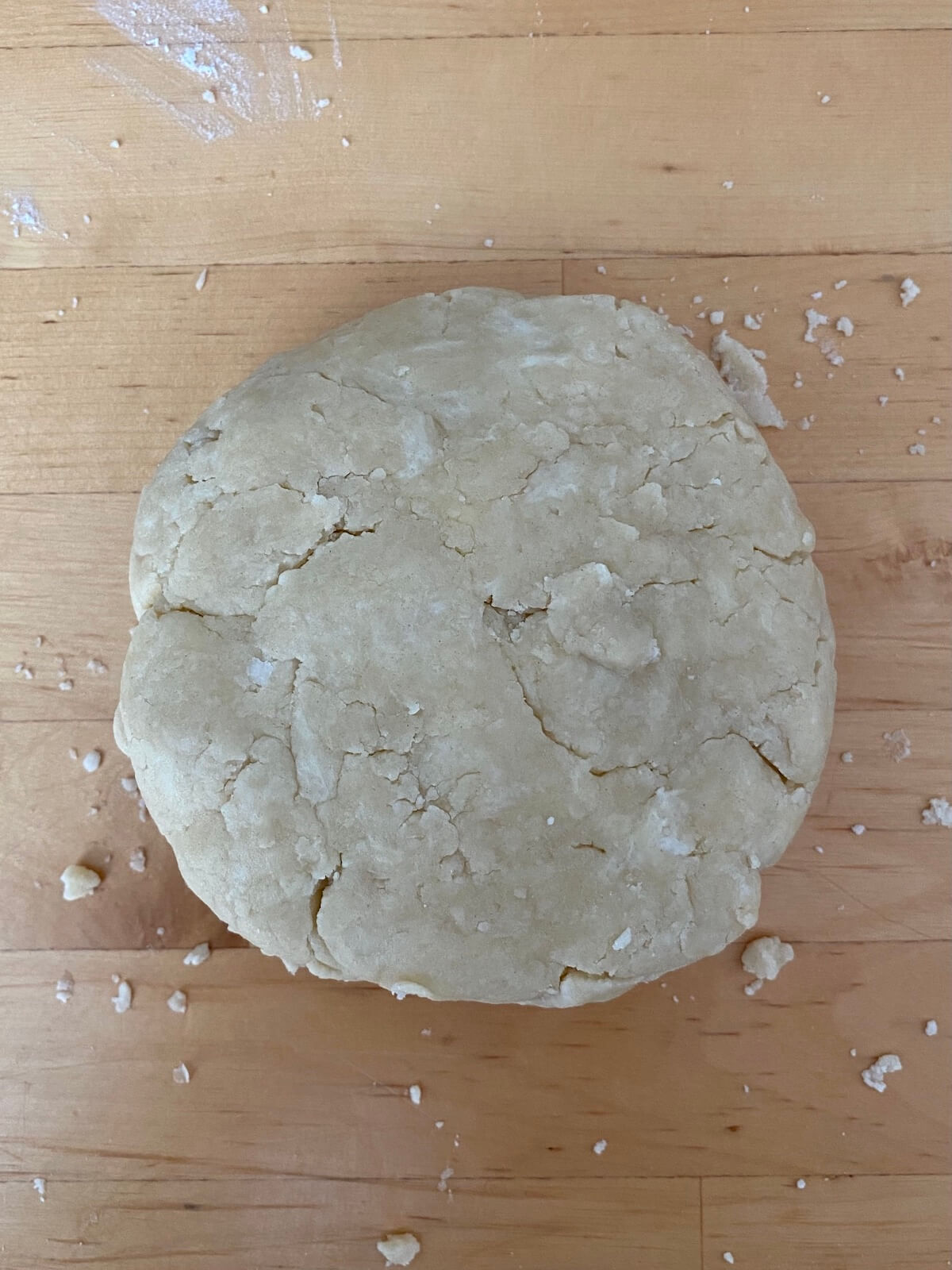
Step 7: Roll out the dough. For most pie recipes, pie dough should be rolled out into a circle, about 12 inches in diameter, and about ⅛ inch thick. Roll the dough out on a lightly-floured surface using a wooden rolling pin.
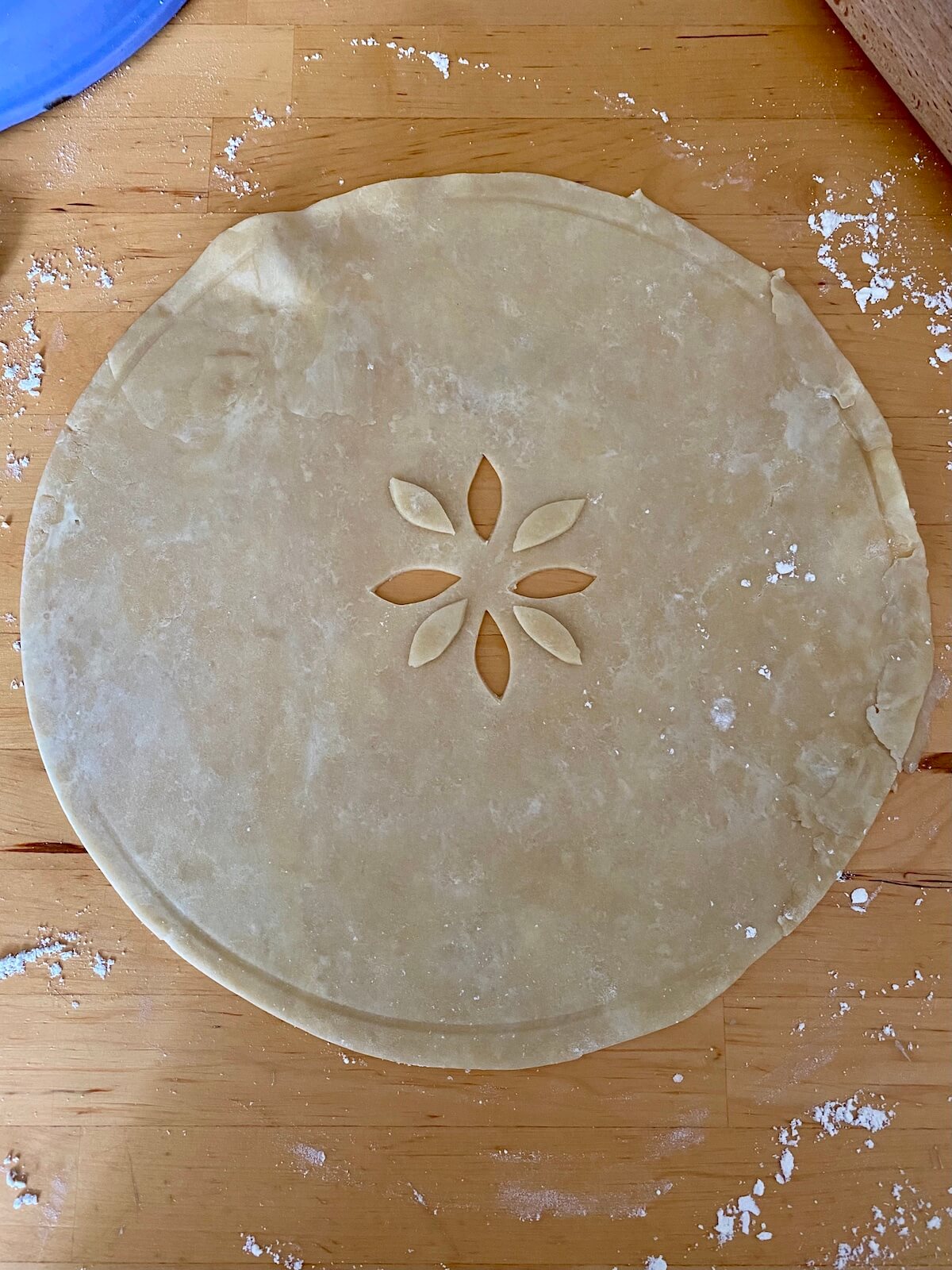
Note: The baking time and temperature for this simple pie crust recipe will depend on the specific pie recipe you are using.
Food Processor Method
Making pie dough in a food processor is a quick and easy alternative to making pie dough by hand. Just take care not to overwork the dough using this method.
To make this 3 ingredient pie crust dough with a food processor, follow these instructions:
Step 1: Prepare the food processor. Fit the food processor with the metal blade attachment. Make sure all parts of the food processor are clean and dry before starting.
Step 2: Combine dry ingredients. In the food processor, add the all-purpose flour, kosher salt, and sugar (if using). Pulse a few times to combine the dry ingredients thoroughly.
Step 3: Add butter. Place the cold, cubed butter in the food processor. Pulse until the butter turns into pea-sized crumbs, leaving a few larger pieces for a flaky texture.
Step 4: Add ice water. With the food processor running, gradually pour in ¼ cup of ice water. Pulse the dough until it starts to come together. If the dough is still too dry and crumbly, add more ice water, 1 tablespoon at a time, and pulse until the dough holds together when pressed.
Step 5: Form dough balls. Dump the dough out onto a clean, lightly floured work surface. Gather the dough into two equal parts and press each half together into a ball. Flatten each ball into a 1-inch thick disk.
Step 6: Chill the dough. Wrap each dough disk tightly in plastic wrap and refrigerate for at least 1 hour, up to 3 days. Chilling the dough allows the gluten to relax and makes the crust easier to handle. Remove the dough from the refrigerator and let it sit on the counter for a few minutes to soften slightly before rolling out.
Tips for Success
- Keep ingredients cold. The key is to keep the butter as cold as possible. Refrigerate it until just before adding it to the dry ingredients and use ice cold water to prevent it from melting too much as you mix the dough.
- Measure accurately. Flour is easy to over-measure when using cups. For better accuracy, use a kitchen scale to weigh the flour in grams. This prevents you from ending up with crumbly, dry pie dough.
- Don’t overwork the dough. Overworking the dough can result in a tough crust. Mix the ingredients just until the dough comes together.
- Adjust water as needed. The amount of water required may vary depending on factors like humidity and flour moisture content. Add water gradually and adjust as needed to achieve the right dough consistency.
- Fill in the gaps. Smooth out rough edges in your pie dough by cutting off longer pieces and using them to fill in the gaps. Gently press the dough into place before using the rolling pin to smooth it over.
- Create a smooth edge. To create an even, smooth edge for your pie crust, use a pizza cutter. Lay your pie plate on top of the rolled-out dough and cut the dough a few inches beyond the edge.

What is Blind Baking (Par-Baking)?
Blind baking is a method used to fully or partially bake a pie crust before you add filling.
For certain recipes, like a quiche, pudding pie, or no-bake pie, this is an important step that helps you achieve a crispy pie crust without having to overcook the filling.
Fully blind-baked pie dough is used when making no-bake pie recipes like banana cream pie or coconut cream pie. A partially blind-baked crust is used for recipes like quiches or custard-style pies.
How to Blind Bake a Pie Crust
Par-baking a pie crust is simple as long as you keep a few things in mind. Here are the steps I use to blind bake pie dough:
Step 1: Chill the dough. After rolling out and placing the pie dough in the pie plate, refrigerate it for 30 minutes. This helps avoid shrinking edges during baking.
Step 2: Weigh down the dough. Preheat the oven to 375°F. Line the chilled pie dough with parchment paper and fill it with pie weights, dry beans, or uncooked rice.
Step 3: Bake the dough. Bake with the weights for about 15 minutes until the edges start to brown. Remove the parchment paper and weights carefully.
Step 4: Dock the pie crust. Use a fork to poke holes all across the bottom of the crust. Continue baking for 7-8 minutes for a partially baked crust or 15 minutes for a fully baked one.
How to Use 3 Ingredient Pie Crust
From stunning Thanksgiving pies to cozy, comfort food meals, this 3 ingredient pie crust is endlessly versatile and can be used in a variety of recipes.
One of the most common ways to use homemade pie dough is to make a classic fruit pie or galette. My favorite sweet pie is apple pie, but blueberry, cherry, or peach pie is also delicious.
Another fantastic way to make use of this basic pie dough recipe is with savory pies, galettes, and quiches. Chicken pot pie, tomato galette, or bacon quiche are all tasty options.
Finally, hand pies and filled pastries are a fun choice if you’re looking to make individual servings or appetizers for a party. Try making apple hand pies, empanadas, pasties, or homemade hot pockets with this buttery pie dough recipe.
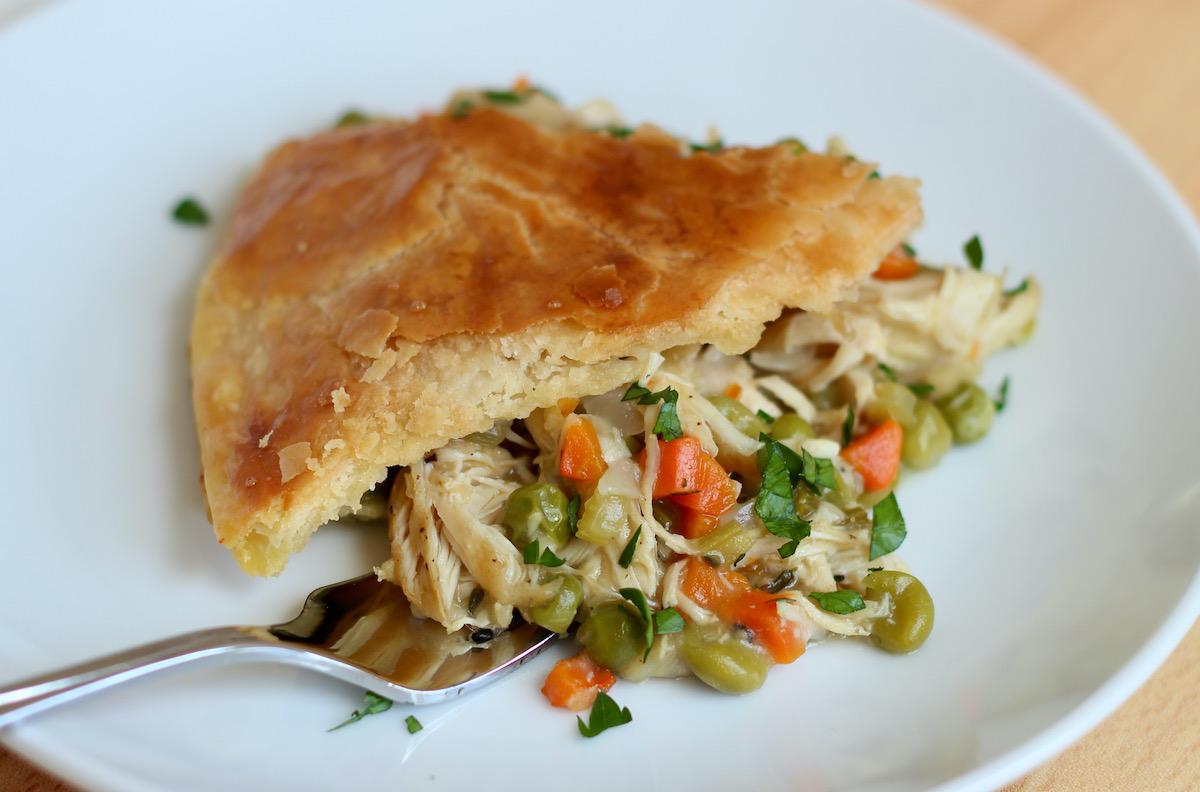
Storage and Freezing
How to Store
- Refrigerator- Store fresh pie dough disks wrapped tightly in plastic wrap in the refrigerator for up to 3 days.
- Freezer- Freeze homemade pie dough for up to 3 months. Thaw in the refrigerator before using.
How to Freeze
Freezing pie dough is convenient, easy, and a great way to stock your freezer with ready-to-use ingredients for busy weeknight meals and last-minute parties.
To freeze this 3 ingredient pie dough:
- Shape the dough. Divide the dough into your preferred portion size and flatten it into a disk.
- Wrap in plastic wrap. Individually wrap each dough disk tightly in plastic wrap.
- Store inside a freezer-safe bag. Place the dough disks inside a freezer-safe plastic storage bag, squeezing out excess air.
- Label and date. Write the recipe name and date on each bag so you know when it expires.
- Freeze. Store the dough disks in the freezer for up to 3 months. Thaw in the refrigerator before using.
Make Ahead
Making pie dough ahead of time is a fantastic way to get a jump start on food preparation for the holidays. Simply prepare the dough according to the recipe and store it in the refrigerator for up to 3 days or in the freezer for up to 3 months.
Frequently Asked Questions
Yes, you can use salted butter in this recipe. You’ll want to reduce the amount of kosher salt to ½ teaspoon.
Yes, you can replace up to half of the all-purpose flour with whole wheat flour. Keep in mind that you may need to add a little more water to the dough if you use whole wheat flour.
No, pie crusts do not need eggs added to the dough. However, an egg wash is often brushed on top of the crust before baking to add color and shine to the finished pie.
Chilling the dough before baking and avoiding stretching the dough when placing it in the pie dish can help prevent shrinkage.
Let's Connect!
Be sure to leave a comment below if you have any questions. You can also connect with me on Instagram, Facebook, Pinterest, or via email at [email protected].
More Pie Recipes
📖 Recipe
3 Ingredient Pie Crust
Equipment
Ingredients
- 2 ½ cups (300 grams) all-purpose flour plus more for dusting
- 1 teaspoon kosher salt
- 1 tablespoon granulated sugar optional (for sweet pies)
- 1 cup (2 sticks or 226 grams) unsalted butter cold, cut into ½-inch cubes
- ¼-½ cup ice water
Instructions
- In a large mixing bowl, whisk together the flour, kosher salt, and sugar (if using) until everything is mixed well.2 ½ cups (300 grams) all-purpose flour, 1 teaspoon kosher salt, 1 tablespoon granulated sugar
- Add the cold, cubed butter to the bowl. Using just your fingertips, pinch and squeeze the butter cubes until they flatten into small sheets. This helps create flaky layers in the dough.1 cup (2 sticks or 226 grams) unsalted butter
- Keep working the butter into the flour until it forms pea-sized crumbs. The mixture will look crumbly but should hold together slightly when pressed. Don't worry if you see a few larger butter pieces; they'll add to the flakiness.
- Measure out ¼ cup of ice water and drizzle it evenly over the dough. Use your hands or a rubber spatula to gently mix the dough until all the flour is moistened. Be gentle and don't over-mix to avoid a tough crust. If the dough doesn't stick together, add more ice water, 1 tablespoon at a time. Stop adding water when the dough holds together when you press it.¼-½ cup ice water
- Dump the dough out onto a clean, lightly floured surface. Divide the dough into 2 equal parts and press each half together into a ball. Flatten each ball into a 1-inch thick disk.
- Wrap each disk tightly in plastic wrap and let them rest in the refrigerator for at least 1 hour, up to 3 days. Chilling relaxes the dough and makes it easier to handle. Before rolling it out, let the dough disks sit on the counter for a few minutes to warm up slightly.
- For most pie recipes, pie dough should be rolled out into a circle, about 12 inches in diameter, and about ⅛ inch thick. Roll the dough out on a lightly-floured surface using a wooden rolling pin.
- Note: The baking time and temperature for this pie crust will depend on the specific pie recipe you are using.
Notes
- See post for instructions on how to make this pie crust in a food processor, blind baking (par-baking) instructions, as well as other helpful tips.
- Storage: Store pie dough disks wrapped tightly in plastic wrap in the refrigerator for up to 3 days and in the freezer for up to 3 months.

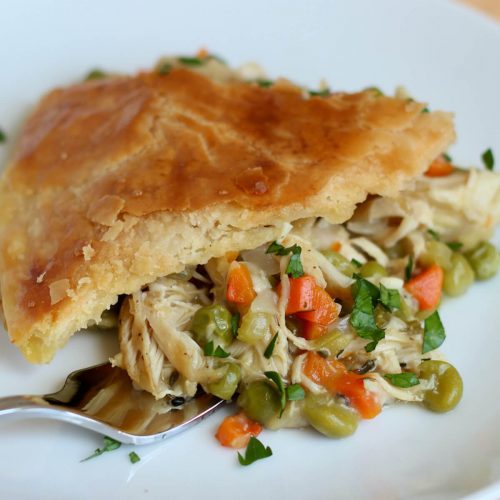
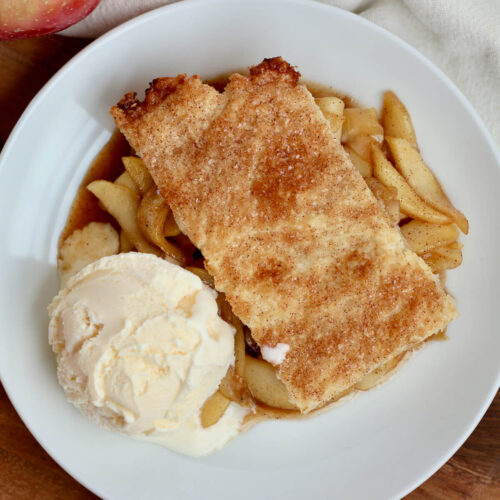
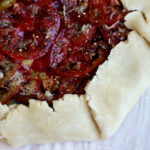


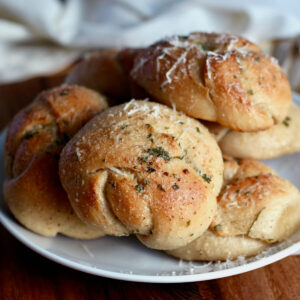
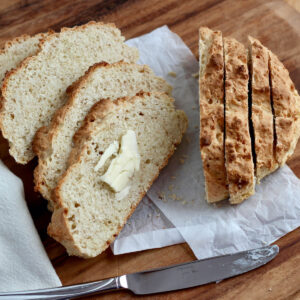
Comments
No Comments